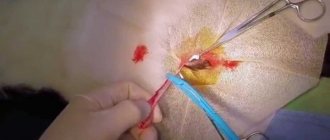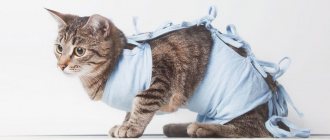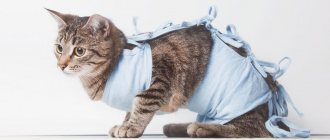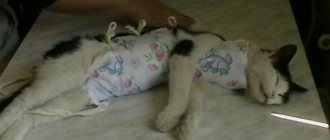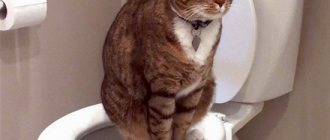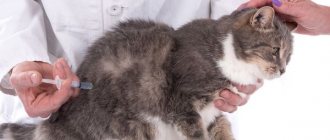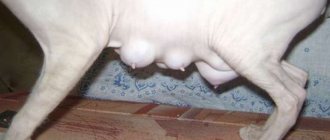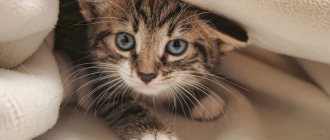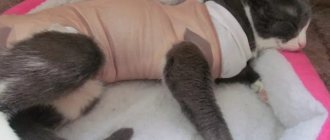Every day, more than one thousand operations to castrate domestic cats are performed in all veterinary clinics. The significance of the procedure is difficult to overestimate, since with its help it is possible to curb the increase in the number of stray animals. The operation itself is quite simple and is often performed at home. But the simplicity of the procedure does not exclude a certain probability of complications. It happens, for example, that a cat bleeds after surgery. What does this mean and should I seek help from a veterinarian?
Cat after castration. Features of postoperative care.
The primary goals for a veterinary surgeon when castrating a cat are to perform the castration and make recommendations so that the postoperative period for the animal passes with the least discomfort and for the owners with the least hassle.
Castration of a cat is a fairly simple operation to perform, but nevertheless it is an operation with all its inherent regalia, such as general anesthesia, tissue dissection, the need for a rehabilitation period and possible rare complications. Compared to sterilization of a cat, castration of a cat is an easier operation in terms of rehabilitation for the animal.
Let us recall that the ultimate goal of castration of a cat is to remove the testes, which in cats are located under the skin of the scrotum (with the exception of cryptorchid cats), while the ovaries of cats are located in the abdominal cavity. Thus, the overall trauma to the tissues that need to be cut to access essential organs in cats is naturally less.
In modern conditions, a cat can be castrated either in a veterinary clinic or at home. In both cases, the rules for performing the operation remain the same, their goals are to remove the testes, prevent postoperative complications, reduce pain and simplify the care of the animal for its owners. Where exactly to carry out the operation is up to you, of course.
Since we conduct it at home, we adhere to the following arguments in favor of this:
- First, the animal does not need to be taken to the clinic; there is no need to plan a trip, find transport, or book the necessary time for this. When a veterinarian comes to your home, his visit lasts 30-40 minutes.
- Second, the animal is not stressed. There are many cases, according to the owners, when cats needed to be given more than one “dose of anesthesia” before surgery to achieve anesthesia. The reason for this is severe stress, which is significantly minimized if the cat meets the doctor on its territory. In this case, only one standard dosage of anesthesia drugs is always required.
- Third, the animal is not at risk of contracting any infections from other visitors to the veterinary clinic. It is almost impossible to organize “healthy” and “infectious” zones in a veterinary clinic to separate sick and healthy animals, so the risk of contracting feline infections is very high. And a simple operation can result in additional hassle in treating the animal.
- Fourth, keeping the animal at home during the period of recovery from anesthesia, which is important during the cold season.
- Fifth, many owners fear that after castration the cat will begin to take revenge and spoil, and this depends on the degree of stress suffered. So after an operation at home, no one shits in retaliation.
But we are not dissuading you from operating in a clinic; if it makes you feel safer, operate on the animal in a clinic. Your peace of mind is the most important thing. If the necessary simple conditions are met, the operation and rehabilitation period proceeds safely, both when performing the operation at home and in the clinic.
There are some differences in caring for a cat when using one or another anesthesia technique. For example, with some types of anesthesia, it is not recommended to feed the animal during the first 12 hours after surgery, mainly because of the possibility of the cat having problems with swallowing, although other drugs eliminate this disadvantage.
Conventionally, the postoperative period can be divided into several parts. In each of them, the emphasis that needs to be paid primary attention to will be different, based on the time elapsed since the operation, the processes occurring in the animal’s body, the biology of the healing of surgical wounds, and so on.
Cryptorchidism is a pathology that involves retention of one or both testes in the abdominal cavity, or in the inguinal canal. Externally it manifests itself in the absence of one or both testes in the scrotum. By palpation, the subcutaneous space in the groin area (between the hind legs) is felt; if the testis(es) are located there, they speak of inguinal cryptorchidism; as a rule, they are smaller in size than normal.
In case of inguinal cryptorchidism, when the testis is located under the skin between the hind legs, an additional incision of the skin on the testis will be required to remove it, after which sutures must be placed at the incision site, which must be protected for 10 days until they are completely healed. As a rule, it is convenient to protect yourself by wearing a special protective collar, which many have already heard about.
It is otherwise called an Elizabethan collar and is sold at a pet store or veterinary pharmacy. In addition, the seams must be treated daily, once a day, with a solution of some antiseptic. An aqueous solution of chlorhexidine or Miramistin is quite sufficient. A cotton pad is moistened with an antiseptic solution and the seam is coated.
If your boy is unlucky and the testis(es) are in the abdominal cavity, which is preferably confirmed by ultrasound before the operation, then you will receive full care similar to the care of a cat after sterilization. Read more, “Caring for a cat after sterilization.”
We wish you a successful castration of your pet and a speedy recovery!
General information
Castration is a surgical operation that involves the removal of both testes (testicles, testicles). Castration of males is carried out under general or combined anesthesia. As a rule, castration takes 20-40 minutes and after a while, if there are no contraindications, the owners can take their pet home.
Important! Castration of cats can be carried out at any age and at any time of the year. At the same time, veterinarians recommend castrating males at the age of 9-11 months, preferably in the spring or in the autumn-winter period. During the hot season, the wound takes longer to heal, and the risk of infection by pathogenic flora increases.
Castration, in contrast to sterilization of females, is a simpler operation, after which postoperative complications rarely occur, but there are exceptions. If the veterinary clinic where the castration operation was performed provides a service for monitoring animals during the postoperative period, we recommend using it. The veterinarian will monitor the cat’s condition and, if necessary, provide timely assistance. The stay of animals in the clinic, as a rule, ranges from one day to three days.
Bleeding
This may occur due to several factors:
- insufficient ligation of the spermatic cord stump;
- when the bandaging is too strong, when additional damage occurs;
- poor quality ligature;
- flabbiness of blood vessels, which causes them to rupture;
- low blood clotting;
- varicose veins of the spermatic vein.
Bleeding from the skin of the scrotum is not a complication. This is a normal reaction of damaged tissue. Such hemorrhage is not profuse, the blood flows drop by drop, quickly coagulates, so that it goes away half an hour after castration.
In this case, the blood flows in a trickle, often small, but sometimes extremely powerful, it all depends on which artery or vein was damaged.
Symptoms. Bleeding can be detected by characteristic traces of blood. In severe cases, anemia, weakness, tachycardia, and the development of shock are added to the symptoms. Sometimes the bleeding becomes internal, so it is detected by pale skin, weakness, and accumulation of blood in the abdominal cavity.
Treatment is only surgical. A repeated resection is performed, the damaged vessel is found, a ligature is applied or it is sutured. To eliminate the symptoms of anemia, you can administer calcium chloride and prescribe iron-containing medications. In severe cases, a blood transfusion is required.
What to do if you are bleeding
As already noted, if the suture bleeds after castration, in case of severe bleeding, immediately contact your veterinarian and take the cat to the clinic. Treatment methods are selected individually and depend on the nature, stage of the complication, and localization of blood leakage.
Capillary bleeding from the spermatic cords is stopped by applying a repeated ligature, and from the scrotum by applying discs soaked in adrenaline. Calcium chloride is administered intravenously. In case of heavy bleeding or anemia, transfusion of blood substitutes is performed. To prevent postoperative complications, infections are additionally prescribed Vikasol, sulfonamides, and complex antibiotics.
Important! In case of severe blood loss, in order to normalize the condition of animals, a donor blood transfusion and special supportive therapy in a hospital setting may be required.
If the complication is caused by poor blood clotting, hemostatic drugs are used in the form of tablets or injections. Euthamsylate (decinone) is used. The drug is highly effective and fast acting. It is prescribed intramuscularly in a dosage of 0.5 ml once or twice a day or 1⁄4 tablets twice a day.
Aminocaproic acid (in powder) helps with bleeding. The veterinarian will advise you on the exact dosage and frequency of feeding.
If your cat's wound is bleeding, but the blood is not coming out much, apply a cold compress. Wrap the ice cubes in a sterile cloth or gauze. Hold for one or two minutes. Repeat this procedure several times until the bleeding stops completely, maintaining an interval of 10-15 minutes. Only the operated area should be cooled. The wound and seam can be treated with peroxide, iodocyrin, or any other antiseptic solution.
To prevent the fluffy from licking, chewing the seams, and causing infection, be sure to purchase and wear a protective cone (Elizabethan collar), which is sold in a veterinary clinic, veterinary pharmacy, and pet stores. If you wish, you can make a protective device yourself from soft plastic, thick fabric, or cardboard.
After surgery, be sure to check with your veterinarian surgeon about what care should be like in the postoperative period. Follow all recommendations, carefully monitor the animal until the end of the rehabilitation period and normalization of the general condition.
Every day, more than one thousand operations to castrate domestic cats are performed in all veterinary clinics. The significance of the procedure is difficult to overestimate, since with its help it is possible to curb the increase in the number of stray animals. The operation itself is quite simple and is often performed at home. But the simplicity of the procedure does not exclude a certain probability of complications. It happens, for example, that a cat bleeds after surgery. What does this mean and should I seek help from a veterinarian?
Let's make a small digression right away. Keep in mind that after a normally performed castration nothing should bleed!!!
In a healthy cat that does not have any pathologies of the blood coagulation system, the primary healing of the postoperative wound begins immediately. Moreover, the scope of surgical intervention during castration is extremely small. In fact, only the skin of the scrotal sac (scrotum) is cut, where there are simply no large blood vessels. The capillaries in this area are instantly blocked by blood clots. Even during the operation itself, very little blood is released. Please note that during the first hour and a half after the procedure, a small amount of bloody fluid (ichor) is allowed to be released, but not pure blood!
But! In cases where your cat is cryptorchid, infertility was carried out through abdominal surgery (the testes in such situations are located in the abdominal cavity), everything is somewhat different.
When a stitch bleeds after castration, there is nothing “supernatural” about this phenomenon. The release of a small amount of it does not threaten the animal with anything serious. This is only true in situations where the bleeding is really minor and continues for a maximum of three days from the moment of surgery.
In addition, it should not be accompanied by redness and swelling of the surgical area, as well as an increase in local body temperature. All these signs indicate the development of an inflammatory process, potentially dangerous to the life and health of the cat.
So the situation when a cat’s wound bleeds after deprivation does not bode well for your pet.
In any case, you will need to contact your veterinarian immediately. The sooner you do this, the better. Otherwise, he may well die from internal bleeding.
Cat after castration in a veterinary clinic
Day of surgery
After castration of a cat in a veterinary clinic, you have a choice: either leave the animal in the hospital for a period of one day until the animal is fully restored and wounds heal (7-10 days), or take it home immediately after castration. Let's look at the advantages and disadvantages, with the advantages of the first option becoming disadvantages with the second option.
We leave the cat in the hospital after castration, advantages:
- first, there is no need to take the animal home immediately after surgery, especially in the cold season;
- second, there is no need to independently carry out postoperative care, injections, administer pills, treat wounds if required, or you do not have free time, do not have the skills and desire to acquire them, if the animal is aggressive or “with character”, if there are no suitable conditions for keeping a cat in the house (for example, when a stray cat is neutered using money collected together, but it is impossible to care for him at home due to the presence of other animals or for other reasons);
- third, you are relieved of responsibility for the correct implementation of postoperative procedures and if complications arise, you have someone to ask;
- fourth, the need for medical supervision of the cat after castration, concerns animals with health problems that require additional monitoring after surgery, and this is important.
We invite you to read: Causes, symptoms and treatment of chlamydia in cats.
Thus, you receive turnkey castration of the cat. We leave the cat in the hospital, disadvantages:
- first, the animal may experience additional stress from being in alien conditions next to unfamiliar animals;
- second, you need to be sure that he (the cat) will actually undergo the required procedures on schedule, and not when they remember (therefore, it is important to take into account the rating of the veterinary clinic according to the majority of reviews from other owners);
- third, upon returning home, after a few days, you may need time to establish a “wet” relationship between you and the cat, many animals are quite touchy;
- fourth, the danger of contracting various viral infections (it is necessary that the hospitals for infectious patients in the veterinary clinic and for healthy postoperative patients be separate; you should not particularly rely on vaccinations, since they protect only from 15% of possible viral diseases);
- fifth, you need to know that the animal will be kept in normal temperature conditions, without drafts and overheating, ask about feeding and report on the cat’s characteristics, allergies, and so on;
- sixth, the use of hospital services in a veterinary clinic requires additional and significant costs depending on the number of days.
This means that if you have firmly decided to keep the cat after castration for the entire rehabilitation period, then you will no longer need further narration.
Damage to the penis
The genital organs (i.e. penis and scrotum) are anatomically very close to each other. Therefore, if castration is performed carelessly (as well as in cases where the cat is poorly fixed and “jerks” a lot), the possibility of damage to the urethral canal cannot be ruled out. Such cases are very rare, but they still happen. And the cat in such a situation faces not only the need for additional surgery, but also a very long recovery period.
Any damage to the penis, which consists of large cavernous bodies, always leads to intense bleeding. It is often so intense that the animal dies from severe blood loss within a few minutes.
Moreover, even with successful relief of hemorrhage, it happens that the tissues of the penis, which are very demanding of nutrition and oxygen, partially die, and processes of necrotic decay develop in them. To prevent an animal from becoming a “eunuch” in the full sense of the word, a complex and very expensive operation for plastic surgery of the penis is required. And, by the way, not every veterinary surgeon will undertake to perform it.
Foreign veterinary periodicals describe cases where, as a result of damage to the penis, veterinarians had to “feminize” a cat, making his penis something like a female vulva. This is easier than forming a new sexual organ.
Scrotal swelling
The development of edema is possible for several reasons:
- penetration of dirt into the wound, which often happens when castrating unwashed pets;
- when castrating an animal in a dirty, dusty room;
- with insufficient cleaning of the scrotal cavity, when clotted blood or severed tissue remains in it;
- tissue separation due to inaccurate movement of the scalpel;
- develops when the doctor fails to comply with antiseptic rules.
The inflammatory reaction is not observed immediately, but only a day or two after the operation. At first, the exudate is serous or serous-fibrinous, but after 3-4 days the process turns into purulent inflammation. The pathology is localized at the initial stage, but later spreads to adjacent tissues, covering the entire scrotum.
The clinical picture is quite bright:
- the scrotum becomes 1.5-2 times larger;
- the number of neutrophil leukocytes increases;
- body temperature increases by 1.5-2°C;
- at high temperatures, shortness of breath and increased heart rate are observed;
- the animal is lethargic and refuses to eat;
- serous or purulent exudate from a surgical wound.
Surgical treatment is possible, consisting of opening the abscess (if there is one) or treating the wound. However, the main therapy is always medicinal - systemic antibiotics. To alleviate the pet’s condition, he can be given intravenous glucose 5%, calcium chloride, or novocaine.
Tissue loss
For example, the omentum, a section of the intestine, the common tunica vaginalis, the stump of the spermatic cord. A fairly rare complication in cats due to the narrowness of the inguinal ring.
Occurs in several cases:
- with an enlarged inguinal ring;
- with strong compression of the abdomen during surgery;
- in case of damage to the inguinal ring (rupture of muscles, ligaments, fractures);
- detachment or degenerative and sclerotic changes in the common vaginal tunica;
- tension of the spermatic cord when applying a ligature;
- low ligature application on the spermatic cord;
- incorrect incision of the scrotum.
Loss of tissue is determined by the presence of an abnormal formation after castration. The hernia can be in the form of a sphere, flap, or cord. In this case, the fallen part of the tissue becomes dirty and infected with the development of purulent processes, edema and hyperemia. When the omentum, spermatic cord or common tunica vaginalis prolapses, the animal does not show concern due to the absence of nerves in these tissues.
But when a section of the intestine prolapses, the pet exhibits a strong pain reaction (colic). In this case, the inflammation spreads to other parts of the intestine and the mesentery, eventually developing peritonitis, the symptoms of which are fever, tachycardia, rapid breathing with depression of the general condition.
Treatment is only surgical. The prolapsed part of the common vaginal membrane or spermatic cord can simply be cut off. The omentum must be set back; if necrosis is observed on it, then the area must be separated with a ligature and cut off.
Intestinal loops should also be straightened, and necrotic areas should be cut off. In this case, it is necessary that the intestine be intact and airtight, so when excision it is carefully sutured. After tissue reduction, the inguinal ring is sutured.
Internal bleeding in a cat after sterilization
The veterinarian places ligatures on the vessels supplying the ovaries and uterus before removing the reproductive organs. If such a ligature comes off, internal bleeding will occur. This probability is extremely low, and many clinics use vascular electrocoagulation technology instead of threads.
Life-threatening bleeding can occur if your cat has a blood clotting disorder. This is possible with rare congenital pathologies, or with a fatal coincidence of circumstances. On a free range, a pet can catch and eat a mouse that has been poisoned but is still alive. As a result, the cat is poisoned with an anticoagulant, which leads to spontaneous bleeding.
If you are taking your cat home immediately after castration
These recommendations are similar to those for castrating an animal at home. The animal may be given to you while still under anesthesia or already moving a little. Unlike cat sterilization, cats do not need to wear any bandages or protective collars. You can absolutely safely allow your cat to lick the wounds.
Be sure to ask whether postoperative pain medication has been taken, and if not, when is it required. A self-respecting veterinary clinic will provide you with a recommendation form for caring for a cat after castration, taking into account all the features of this operation in this clinic.
It is advisable to sit in the clinic for another 30 minutes to make sure that there is no bleeding from the suture.
It is necessary to get home as quickly as possible, especially in the cold season, which is extremely important for smooth-haired and “fine-haired” cats. Be sure to place the animal in a spacious carrier, provide means for wrapping it up during the cold season, and if the journey is long, a small heating pad.
Sufficient space in the carrier will give you the opportunity to easily observe the cat, and will also provide sufficient room for the animal to move if it begins to recover from anesthesia during the trip home. Some owners take the presence of a carrier lightly and hold the animal in their arms, but there have been many examples when the animal, still in an inadequate state, escaped from the hands of its owners on the street and all this led to a disappointing search for it in the gateways.
And if you are returning home by car and the animal starts to move away during the trip, in a panic he may begin to circle around the inside of the car and, God forbid, get under the pedals. In such cases, an accident is not far away.
During transportation, as well as during periods of immobility, the animal should lie on its side, and air should flow freely to the animal’s nose. Positioning the cat on its side will allow the vomit to come out freely when vomiting occurs, rather than getting into the trachea and causing aspiration pneumonia, a serious complication.
When you arrive home, if the carrier is free, it would be better to leave the cat in it, placing it in comfortable temperature conditions (22-24 degrees Celsius). It is required to turn a motionless animal every 30 minutes from one side to the other. The cat should also be on soft bedding, wrapped up.
We suggest you read: Jagdterrier care and maintenance
In addition, it is important to periodically close the eyelids and massage the eyeballs to prevent severe chapping of the cornea, which can lead to subsequent keratitis (inflammation of the cornea); you can instill some preventive eye drops or close the eyelids and secure them with an adhesive tape.
You should not place the animal in a draft or near heating devices; it can either become hypothermic or overheat, and a stationary animal is not able to change its place of stay. The best option is to cover the animal at normal room temperature, plus a warm heating pad if there is body shaking.
If it is necessary to give painkillers (provided that they were not done at the veterinary clinic, then the injection can be done at this stage; painkillers that are given orally cannot be given until the animal can swallow normally). Check if the wound is bleeding. A small amount (small streaks) of blood is acceptable, but large amounts are not.
After some time (1-2 hours), the animal begins to come to its senses, showing motor activity. He doesn't need help. The main thing is to ensure that the cat does not accidentally get stuck somewhere where the still quite influential spirit of Morpheus will bring him. Very important: all windows and vents must be closed! Also, eliminate all possible causes for a stupid fatal accident or unnecessary injury.
Some cats may experience a period of anxiety and agitation when recovering from anesthesia. It manifests itself in the fact that the animal begins to overreact to noise and attention to itself, and like a rocket, it circles around the apartment, colliding with everything that comes in its way. No need to worry.
Full confidence of movements will return to him in a few hours (from 4 to 12 hours) depending on the characteristics of the body. The cat may fall asleep again, but this is only good. In our recommendations, we do not limit the animal’s movements after castration, since we have no concerns about wounds; in your situation, consult a surgeon first.
The start of feeding will depend on the recommendations of your surgeon. In our practice, it is allowed to feed in small portions as soon as he begins to be interested in food. Based on the characteristics of the cat’s body: the faster it eats, the faster the remaining anesthesia will “dissipate.” But this is subject to normal swallowing and no vomiting. If vomiting occurs after feeding, wait 3-4 hours to feed.
Clinical manifestations of bleeding
Bleeding after castration can be venous, arterial (from arteries, veins of the scrotum, artery of the spermatic cord, pampiniform plexus, testicular arteries, vas deferens arteries), as well as primary and secondary.
Primary is noted during surgery, secondary – several hours or days after the procedure. There is also a distinction between external and internal bleeding. External is diagnosed by external manifestations, internal - by symptoms of anemia.
When veins are damaged, the blood has a dark color and viscous consistency. When the arteries are damaged, the blood has a bright scarlet color and is released in droplets, a thin weak or strong stream. In this case, the pressure of the jet changes depending on the position of the cat’s body. For example, bleeding increases if the cat gets up and is active, and decreases during sleep.
Important! The most dangerous to the life and health of animals is venous bleeding from the vessels of the spermatic cord, internal bleeding into the peritoneum.
Severe internal or external bleeding leads to the development of anemia, which can be understood by the pale color of the mucous membranes. The animals are weakened, sleep most of the day, try to hide in dark places, are reluctant to react to stimuli, and refuse their favorite treats and food. The temperature may be increased by one or two degrees or decreased. In acute bleeding, breathing becomes rapid and the heart rhythm is disturbed.
If your cat is bleeding from a stitch, there is noticeable heavy bleeding upon arrival home, or bleeding from the wound starts a few days later, immediately take your pet to the veterinary clinic. Otherwise, the cat will lose a lot of blood, which will lead to the development of severe complications. If help is not provided in time, the pet will die from severe blood loss.
Inflammation of the common vaginal lining
A fairly common phenomenon that occurs due to:
- shell detachment;
- administering too much novocaine;
- improper incision of the scrotum;
- blood clots remained after the operation;
- dirt ingress;
- burn of the shell with an alcoholic antiseptic solution.
If you cut the tunica vaginalis to insufficient length, it will not extend upward. The drooping sheets of the membrane form connective tissue adhesions, inside which exudate accumulates. If there is no infection in the cavity, the exudate will resolve on its own after some time. But when bacteria penetrate, purulent inflammation occurs.
Signs of an inflammatory reaction are as follows:
- swelling of the scrotum;
- temperature increase by 1-2°C;
- increased level of neutrophil leukocytes;
- weakness, lethargy, the animal refuses food;
- soreness of the scrotum;
- when palpating, a fluctuation is heard;
- a small amount of purulent exudate may be released;
- the pus is semi-liquid, yellowish, containing fibrin;
- when the adhesion ruptures, exudate comes out in large quantities.
For treatment, surgical opening of the adhesions is used; after removing the exudate, the pain is eliminated, the temperature drops, and the animal quickly returns to normal. The scrotal cavity is treated with antiseptics (3% hydrogen peroxide solution). At high temperatures, antibiotics can be prescribed.
Funiculitis occurs for several reasons:
- contamination of the spermatic cord;
- when the stump falls out of the seam;
- excessively large crush area (with bloodless castration);
- tightening the ligature on the area of the vascular cone;
- coarse threads;
- the area below the sutures is too long.
With an inflammatory reaction in the spermatic cord, a response of granulation tissue in the form of inadequate proliferation is possible. The overgrown granulation tissue forms a granuloma, which is saturated with fibrin. Because of this, the granuloma becomes an irritant of the inflammatory process, as a result the circle closes, the inflammation becomes self-sustaining. As a result, due to random division, granulocytes degenerate into a tumor.
Even if the complication is limited only to ordinary inflammation, without degeneration into a granuloma, it is still very dangerous. Since the inflammatory purulent process can spread along the spermatic cord into the abdominal cavity. As a result, peritonitis and sepsis occur, which can even lead to the death of the pet.
On the first, and on any of the subsequent days, but not after the 5th day, theoretically, a cat after castration may have a body temperature above 39.0 degrees Celsius. The value of this indicator depends on the reactivity of the body, or in other words, on how quickly or strongly it is able to respond to tissue damage, on its sensitivity.
An increase in body temperature does not mean that the animal has contracted an infection, or that the body is becoming infected with a surgical infection. The operation itself is accompanied by tissue damage (skin incision, removal of testes), which leads to the release of inflammatory mediators from the damaged tissues, substances that trigger the body’s protective reaction called inflammation.
After all, it is important to understand that inflammation is primarily a protective reaction of the body aimed at healing. Therefore, an increase in a cat’s body temperature to 39.5 degrees Celsius is absolutely normal. Of course, the animal looks sad, but the use of painkillers will relieve the temperature and improve well-being.
If the temperature is higher than the specified tolerance or occurs after the 5th day, consult a doctor. If you had surgery in a veterinary clinic, and your body temperature rose above 40 degrees Celsius, the first thing you need to do is rule out a viral infection.
Pulmonary edema in a cat after sterilization
Long gone are the days when pets were anesthetized “by eye,” and the owners begged the doctor “not to overdo it.” Now veterinary clinics have modern and safe means of anesthesia. Large clinics use inhalation anesthesia and epidural anesthesia. Despite this, general anesthesia can cause dangerous complications in cats after sterilization.
If your cat has problems with the heart muscle (hypertrophic cardiomyopathy, congenital defects), pulmonary edema or thromboembolism may develop after surgery. Both complications can lead to the death of the animal, even if the owner notices something is wrong in a timely manner and consults a doctor.
As a doctor, I recommend doing a cardiac ECHO (ultrasound) before surgery. So we can be calm or, on the contrary, look for options for anesthesia and medicinal support. In practice, owners most often refuse the study to cut costs. With the words “Yes, this is a cat, what will happen to her.” To be fair, I note that most cats do tolerate anesthesia well. But there are breeds in which HCM (hypertrophic cardiomyopathy) occurs much more often than in outbred cats. Here are some popular cats that are at risk:
- Maine Coons;
- Sphinxes;
- British cats;
- Scottish cats.
Pain relief for cats after castration
Attention! The assertion of some veterinarians that there is no need for pain relief after castration of a cat with the argument that the cat is not in much pain is NOT SOUNDED.
Anesthesia is required immediately after surgery, although a general course of 1-2 injections is quite sufficient!!!
Painkillers will allow a more comfortable existence for the cat, allowing for earlier appetite behavior, which is important for the prevention of liver lipidosis. Pain relief normalizes metabolism, suppresses the appearance of temperature as a result of surgical trauma, and reduces the pathological effect of pain on the functioning of such important organs as the liver, kidneys, adrenal glands, pancreas and heart.
In addition, pain relief helps prevent the formation of negative emotional reactions towards people. A peculiarity of cats is that with severe pain, a spasm of the urethra occurs and the animal cannot urinate normally. They begin circling in one place, meowing, and releasing single drops of urine, but without blood.
In the modern world, there is such an arsenal of painkillers that it is not difficult to choose the necessary drug for any animal, even those with health limitations. Many human pain medications are not suitable for cats. Specialized medications are required. Don't hesitate to give paracetamol.
Here is an article about what happens from using paracetamol in cats. In short, a cat can die from paracetamol. Proven effective and safe modern painkillers for cats are “Ketofen” (ketoprofen) tablets and solution for subcutaneous administration (1% solution), “Ainil” 1% solution (ketoprofen), “Previcox” tablets and solution for parenteral administration, suspension for oral administration "Loxicom" (meloxicam) and others (the instructions of which should indicate that this drug is suitable for relieving postoperative pain).
Consult your veterinarian for dosage or use as directed. You can use “human” Ketonal (composition: Ketoprofen). “Ketonal” in the amount of 0.2 ml per 5 kg of live weight mixed with 1 ml of saline or water for injection, subcutaneously, 3-5 days 1 time per day, if you cannot inject, half of this dosage can be taken orally in in the same mode (same effect).
We suggest you read: Horse grooming, how to trim a horse yourself
For some drugs, the frequency of use is recommended once a day, but from experience, the effect of some drugs, especially in the difficult first days after castration, lasts no more than 10-12 hours. If this happens, we allow repeated administration of painkillers at a dose of 1-1/2 of the recommended dose according to the instructions on the same day, that is, general use not once a day, but 2 times a day.
Of course, there are no exceptions, and there are cats who, judging by their absolutely relaxed behavior and normal appetite, do not require painkillers. Such animals have a high pain threshold, so they do not feel pain or it is insignificant. Such animals are found among cats of the Persian and British breeds.
The cat's seam came apart after sterilization
A tiny cosmetic stitch after sterilization of a cat normally heals quickly without a trace. However, this is not always the case. Sometimes owners are forced to return to the clinic again because the cat’s stitch has come apart after sterilization.
The most common cause of this problem is neglect of the veterinarian's recommendations. If after surgery the cat does not wear a collar or blanket, it will tend to lick the stitches.
Together with saliva, an infection enters the wound, and severe inflammation (festering) of the suture occurs. In this case, no threads will hold the fabric together. In addition, with its rough tongue, a cat can get rid of stitches ahead of time.
If the suture discrepancy is minor, the doctor may prescribe “conservative” treatment. First of all, you need to stop the seam from licking. Then local blockades are made (Novocaine 0.5% with an antibiotic), the wound is washed 1-2 times a day. Sometimes healing ointments and preparations such as Vinilin are used. Treatments sometimes last a long time, 1-2 weeks, so I urge owners to take care of the suture immediately after surgery to avoid such problems.
Minor divergence of the cosmetic seam (the cat was not wearing a blanket)
If the suture is severely torn, the only treatment option is surgical revision of the suture under general anesthesia. The doctor will remove non-viable tissue and sew up the belly again. In this case, removable external sutures are usually placed and a systemic antibiotic is prescribed. Case from practice:
The cat was sterilized in a third-party clinic, the external and internal seams were made with silk, the cat did not wear a blanket
Severe seam divergence, 3 weeks have passed since sterilization
All non-viable tissue was removed and sutures were re-sutured.
The same cat after removal of stitches (12 days after wound revision)
Appetite, thirst and natural functions
After sterilization, the cat's appetite should appear within the first 2 days. This is largely facilitated by painkillers. Fasting for more than 5 days is a sign of ill health and requires consultation with a doctor. Appetite and thirst should reach the same level as before castration. Many owners immediately wonder about changing the diet for their cat to a diet intended for cats after castration.
Remember, it is not recommended to change anything in the diet for the first 10 days for a favorable completion of rehabilitation, because if the cat is skeptical about the new diet, the cat’s malnutrition will not bring anything good. Some cats, after castration, even lose a little weight at first due to changes in the physiology of the body.
It is only necessary to switch to a special diet when you notice that the animal begins to gain weight, and this is noticeable by an increase in fat deposits between the ribs and skin. Sagging belly is not an indicator of obesity. You can also find saggy abdominal folds in thin animals. Focus on the amount of fat deposits between the ribs and skin. It is important to evaluate this no more than once every 2 weeks.
Urination may be less in the first days, especially in the absence of appetite; increased urination, as well as its absence, requires consideration and consultation with a doctor. For painful urethral spasm, follow the recommendations in the paragraph on pain relief therapy.
Damage to the urethral canal
In even rarer cases, castration may be complicated by damage to the urethra. In the urethra itself, of course, there are not many large blood vessels, but the available quantity is enough for the development of clearly visible bleeding. In particular, blood will constantly appear in the urine of such a pet.
In severe cases, urine will look like tomato juice . The most severe situations are characterized by gradual leakage of urine from the damaged urethra into the surrounding tissues of the penis. Since urine is a liquid that is very caustic from a chemical point of view, everything ends in severe necrosis of the penis. This often leads to the need for surgical amputation, as a result of which the cat becomes disabled.
The most unpleasant thing is that the owners sometimes don’t notice anything for a long time . In such cases, blood is released briefly and in small volumes. It, being mixed with urine, accumulates in the cavernous bodies of the penis and begins to rot there. Within about two days, the penis swells greatly, turns red, and becomes very painful. As in the previous case, this pathology requires immediate hospitalization of the cat and additional surgery. There is nothing you can do about this at home.
Conclusion. What should you do if a recently operated cat is bleeding from somewhere in the genital area? Contact a veterinarian immediately! This is the only way you can protect the health and life of your pet.
Retroperitoneal abscess
It is a secondary complication that develops from inflammation of the common vaginal membrane or spermatic cord, when the pathological process penetrates through the inguinal ring into the abdominal space. The abscess is usually localized under the pariental peritoneum, in the area of the internal inguinal ring. The inflammatory process often involves the bladder, rectum and colon, retroperitoneal tissue, omentum and mesentery.
Develops 2-4 weeks after castration. Manifests itself in the form of sepsis syndrome:
- heat;
- lethargy, apathy, the cat does not eat anything;
- rapid pulse and breathing;
- stiff gait due to pain in the groin;
- the stomach is tense;
- when the bladder is involved, difficulty urinating occurs;
- if the intestines are involved, defecation causes pain.
It is treated with antibiotics; recently a very modern method has been used - irradiation of the blood with ultraviolet rays. Surgical treatment is possible, which consists of opening the abscess, removing exudate and cauterizing its walls with alcohol.
Is it necessary to protect wounds after castration of cats?
Cats usually do not need stitches on their wounds; they heal well without them. Sutures are required to be placed only if there is noticeably increased leakage of blood from the tissues of the scrotum, however, using statistics, we will stipulate that this was used in our practice only 1 time in 2500 cases of surgery.
But there is no need to protect open wounds either. You can absolutely calmly let your cat care for your scrotum. In addition, there is no need to remove the filler from the tray. After surgery, normal adhesive inflammation occurs at the incision site, so nothing can get inside the wounds. However, there are always special cases. Follow your surgeon's recommendations.
If an animal has problems with blood clotting after castration, a fairly long period of blood leakage can be observed. In this case, blood begins to accumulate not only on the scrotum, which is absolutely normal, but begins to flow down the back of the thighs to the heels. In such cases, when the animal sits down, a noticeable stain of scarlet blood remains in this place.
To prevent such a complication, it is necessary for all animals to receive a prophylactic injection of ethamsylate (Dicinone) after surgery. This drug is sold in a “human” pharmacy. If bleeding occurs, it is important to use etamsylate, whose activation time is 4 hours, and not Vikasol, which requires 2 days to activate.
Poor ligature application
You need to understand what exactly happens during the operation.
- The veterinarian cuts the skin of the scrotum.
- Cuts the testicular ligament.
- Places a clamp and ligature on the cord formed by the vas deferens and blood vessels.
The latter enter the abdominal cavity through an opening called the inguinal ring. The life of the animal depends on the quality of the ligature over which the testis is cut off. If the suture material was placed carelessly, or the thread used for the dressing was of poor quality, the knot will almost inevitably become loose. The worst thing is that the stump of the cord after the operation goes into the abdominal cavity...
What will happen as a result? Nothing good - massive bleeding will develop, as a result of which the entire abdominal cavity can turn into a container for blood. The only way to save the cat is immediate abdominal surgery. During this process, it is necessary to urgently find the “escaped” vessels and re-bandage them. There are cases where animals died within half an hour, when the owners had just managed to pick them up from the veterinarian.
Not in all cases, a poor-quality ligature is to blame. Practitioners believe that approximately 0.5-1.5% of all cats have pathologies of the blood coagulation system (for example, thrombocytopenia of various etiologies). If they are not identified in time and surgery is performed, the cat may die from massive hemorrhage, even if the castration itself was performed perfectly.
Please note! Poor blood clotting cannot be detected by eye. It is in order to identify such pathologies that it is necessary to conduct a full medical examination of the animal at the stage of preparation for castration.
